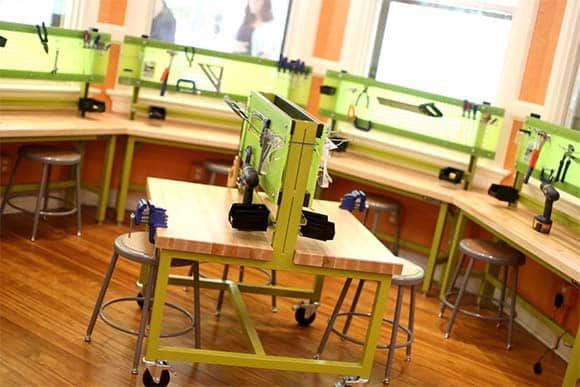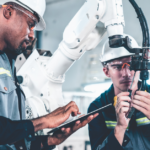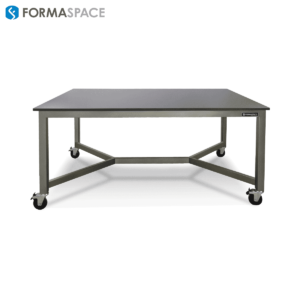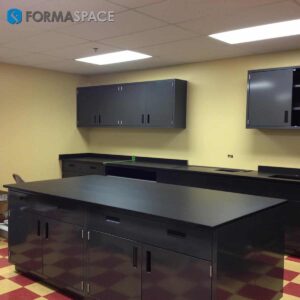For those of us working in the manufacturing industry, the concept of hands-on learning is a natural way to investigate problems and come up with creative solutions. But for many, hands-on learning has become the exception rather than the rule. Fortunately, the increasing number of Makerspaces provides exciting new opportunities for hands-on learning, problem-solving, and creative experimentation.
If you don’t have a lot of experience making things by hand, the habits and vocabulary of those of us with careers in the world of product development, engineering and design, manufacturing and production or science laboratories might seem very foreign indeed.
You may notice a product engineer or a lab manager carrying around a small notebook or doodling on a napkin during dinner to capture ideas. It’s likely you’ll overhear references to things like concept sketches and ideation, hot glue guns and foam core, CNC machines, STL models, working prototypes, hacked hardware made from breadboards and Arduino shields, software kludges, and frankencode served up on a Raspberry Pi.
In the world of the creative maker, these terms (and many more) are just part of a perfectly normal daily conversation. But if it sounds to you like creative makers are using a foreign language designed to isolate themselves into an exclusive club, you’re wrong!
Quite the opposite in fact. The wide-ranging maker community is especially welcoming to newbies and wants more and more folks to discover the joy of making things yourself – by hand. In fact, if we had our way, every city would have a commercial Makerspace, like the TechShop here in Austin and every science center and every library would have a 3D printer and other Makerspace gear on hand.
Educators Have Long Recognized the Value of Hands-On Learning
Fortunately, we are not alone.
Across the nation and around the world, more and more educators are proving to be important allies in promoting a revival of hands-on learning, both in the classroom and in Makerspaces.
Why? Thanks to their inherent emphasis on hands-on learning, Makerspaces are an excellent way to improve learning outcomes.
A Short Lesson in Epistemology, Constructivism, and Constructionism
There’s quite a tradition in education for hands-on learning, so let’s take a short history lesson going back to the 1920s — to the start of Swiss clinical psychologist Jean Piaget’s career at the University of Geneva — which has a surprising connection to the technology used in today’s Makerspaces.
Jean Piaget is one of the major figures in the theory of knowledge (epistemology); he developed a theory of human cognitive development based on four distinct mental growth stages (infancy, early and late adolescence, and adulthood.) Piaget also theorized that we learn using abstract mental models, or constructs, which has given us the name Constructivism to describe both his theory and the pedagogic teaching methods that utilize this theory in the classroom.
Piaget’s star student and protégé, Seymour Papert, extended Piaget’s theory of Constructivism. In Papert’s view, the act of learning by doing (e.g. constructing things) has tremendous value in cognitive development; Papert called his pedagogic approach Constructionism.
Do Papert’s ideas sound a lot like experimenting in a Makerspace to you? Yes, they sure do. But hold on, there’s more to the story.
In the 1960s, Papert came to believe that adolescents should program computers… and not the other way around.
Along with three others, he developed the first programming language, LOGO, designed for children, a language whose descendants include Cricket, LEGO, Scratch, Makey Makey and NetLogo — languages still in use today by many students in schools and Makerspace facilities.
Together with his colleague Marvin Minksy, Papert co-founded both the famous Massachusetts Institute of Technology (MIT) Artificial Intelligence Lab and the MIT Media Lab.
In 1980, Papert wrote the influential book, Mindstorms: Children, Computers, and Powerful Ideas, which continues to inspire the maker movement today. In a tribute to Papert’s book, the LEGO Company named their revolutionary new line of robotics kits “Mindstorms” — which have also served to inspire a new generation of hands-on electromechanical experimenters and inventors.
Fascinating stuff.
What Does Research Tell Us about the Benefits of Hands-On Learning for Education and Career Development
With the pedagogy lesson out of the way, let’s take a look at some of the research that shows how hands-on learning can help students advance in school, help them choose a suitable field of study, and ultimately achieve success in their chosen careers.
Pre-School to Elementary School
Let’s start with younger students first.
According to The Scholastic Differentiated Instruction Plan Book, students between ages four and seven are developing visual and spatial abilities associated with the brain’s right hemisphere. This is an ideal age to have students learn by doing projects with their hands — by constructing projects out of paper and other craft materials using scissors and glue, they get an opportunity to touch and manipulate things, which activates and stimulates their brain functions.
Middle and High School Students
What about adolescents and teenagers? Does hands-on learning help them become better students? Does hands-on experimentation help students come to appreciate the potential of career choices in science and technology?
The answer is yes — to all of the above, according to a study by Purdue University. In this controlled study, half the eighth-graders followed a standard Indiana science lesson plan to learn about water usage and water quality. The other half of the students were asked to build a working water purification device to show they understood the concepts taught in class.
The study showed that students who participated in the hands-on learning displayed higher levels of thinking in open-ended questions and greater content knowledge.
According to Melissa Dark, assistant dean for strategic planning in Purdue University’s College of Technology, “… the students who were involved in a hands-on project learned more and demonstrated a deeper understanding of the issues than the traditional group. This is a significant finding because it proves that with some students — especially groups traditionally underrepresented in science and engineering — the book-and-lecture format may not be the best way to engage students in learning.”
College and University Students
What about young adults enrolled in college or university? Is there evidence that hands-on learning can improve their academic performance when learning difficult concepts, such as in math or science?
Yes, according to a University of Chicago led study, published in Psychological Science, which found a group of physics students performed 7% better on tests if they used hands-on equipment to learn complex physics concepts, compared to the students who were taught using traditional lectures.
“In many situations, when we allow our bodies to become part of the learning process, we understand better,” said lead investigator Professor Sian Beilock, author of How the Body Knows Its Mind. “Reading about a concept in a textbook or even seeing a demonstration in class is not the same as physically experiencing what you are learning about. We need to rethink how we are teaching math and science because our actions matter for how and what we learn.”
Hands-On Learning and Professional Development
There are numerous studies which support the value of hands-on learning for professional development.
Two items caught our eyes and are worth mentioning here.
First, the American Chemical Society (ACS) has come out in favor of the importance of hands-on laboratory science, with a statement that “Hands-on laboratory science experiences are critical to the learning process across all areas of study, beginning with kindergarten and continuing through post-secondary education. Research has shown that students who engage in well-designed laboratory experiments develop problem-solving and critical-thinking skills, as well as gain exposure to reactions, materials, and equipment in a lab setting. Sustained investments in hands-on experiences help inspire students to further their education and prepare them for high-technology careers by fostering skills sought by potential employers.”
In summary, the ACS believes “Computer simulations that mimic laboratory procedures have the potential to be a useful supplement to student hands-on activities, but not a substitute for them.”
The second item that caught our eye is a study on the value of doodling. Some may find the act of doodling on a pad of paper disrespectful during a meeting, but, according to a study in the journal Applied Cognitive Psychology, doodlers have nearly 30% better memory retention during dull verbal presentations.
Why should doodling help us with recalling details? Researchers think that simple, hands-on tasks can help us stay on track mentally and avoid drifting off into daydreams.
Useful Resources for Educators Using Hands-On Learning Techniques
Here are four useful resources for hands-on learning (the first one is free to download).
- Meaningful Making: Projects and Inspirations for Fab Labs and Makerspaces by Paulo Blikstein, Sylvia Libow Martinez, and Heather Allen Pan.
Download this title for free from Stanford University’s FabLearn website.
- FabLab: Of Machines, Makers, and Inventors (Cultural and Media Studies) edited by Julia Walter-Herrmann and Corinne Bueching. Title available from Amazon.com
- Maker-Centered Learning: Empowering Young People to Shape Their Worlds by Clapp, Ross, Ryan, Tishman.
This book is from the Agency By Design team, which is an initiative of Project Zero at the Harvard Graduate School of Education.
Title available from Wiley.com
- Invent to Learn: Making, Tinkering, and Engineering in the Classroom by By Sylvia Libow Martinez and Gary Stager.
Title available from the website Inventtolearn.com
Ready to Get Your Hands Dirty?
If all this talk about learning by doing has whetted your appetite for some creative projects, the next step is to contact a Formaspace Design Consultant.
In the video above, can you spot the Formaspace workbenches we built for the new Create space at the Arizona Science Center?
We’ve had the pleasure of working with both large institutions and small organizations to design and build the key furniture components for Makerspace facilities.
So if you are looking to build or expand a Makerspace or you want to add Makerspace elements to your library, laboratory or even home workshop, get in touch with us today.








